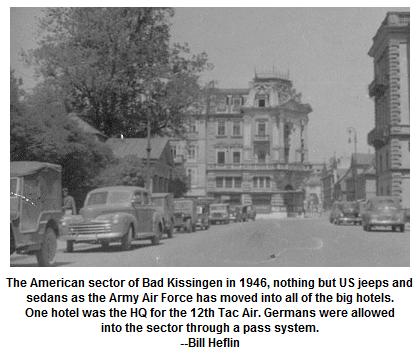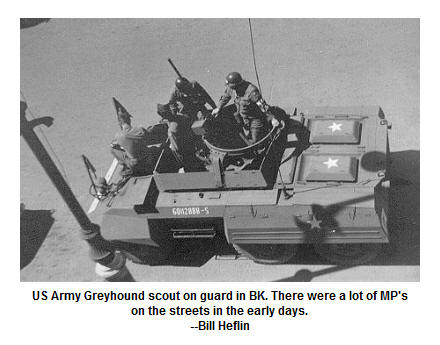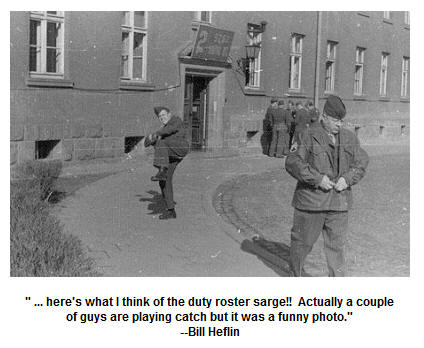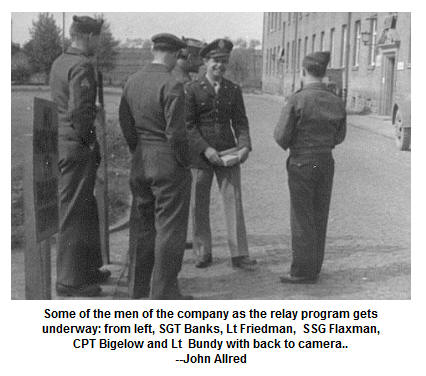| |
Stephen Kranovich:
"In early 1946, I was assigned to the 4th Tactical Communications
Squadron and we were living in Bad Neustadt. The locals had been
given 24 hours to clear out of their houses and we moved in. I
recall we were living near the big Grundig radio factory and we
didn't have much to do. In 1947, a few of us were assigned to the
926th and we were moved into that big German barracks down the road
in Bad Kissingen and things got busy. That's the way things were
with "Dog" Company, 926th Signal Battalion."

Company D, 926th Signal Battalion - 926th Signal
Outpost Operations Company - First Radio Relay Squadron ... every
dog has its day
This is the story of how an Army signal battalion, assisting with the
development of new combined arms fighting theory, became one of the
first US Air Force squadrons in Germany and then continued to play a
key role with emerging technology in support of communications in
the European theater. Only in Bad Kissingen for a short period of
time, Company D traces its beginnings to 1 September 1943 in
Aldermaston, England. The unit story flows across France and
Belgium, then through Germany with the American fighting
forces and finally to the post war period and the Kaserne on the
hill.
The Army Air Force 9th Tactical Air
Command, marshaling over 25 fighter - bomber squadrons, a part of
the 9th Air Force, provided the close air support for attacking
ground units from the first days of the Allied invasion at Normandy
until the end of hostilities. To provide the communications links
necessary for ground commanders to make their requests for fighter
bomber support and then actually coordinate the attacks with in
bound pilots was just one mission of the 926th and they wrote,
tested and re - wrote the doctrine for radio coordination of close
air support as the Allies stormed across Europe. Much of this
development was trial and error, they were always looking to solve
problems as the units pressed forward. What seems so simple
now, coordinating aircraft with ground units in real time, during
the war years was a major challenge.
Stephan Kranovich:
"I checked my old orders and the 926th Signal Battalion really ceased
to exist as of October 47, that's when the 926th S.O.O.C. was organized. As I recall, for most of that Summer and Fall, we were
the only company that really was staffed, the others were drawn down
to no personnel. Most of this was in Bad Kissingen and it is when
the radio relay program was really taking off."
organized. As I recall, for most of that Summer and Fall, we were
the only company that really was staffed, the others were drawn down
to no personnel. Most of this was in Bad Kissingen and it is when
the radio relay program was really taking off."
"In the immediate post war period, the 12th TAC Air HQ moved to Bad
Kissingen. The 926th followed from Erlangen and the supporting
signal companies that had been spread out all across Europe
followed. It seemed as though the men were just passing through long
enough to turn in their equipment and begin processing for return to
the United States. Initially the Hqs. & Hqs Detachment, 926th Signal
Bn was located in the first barracks on the left, Building # 2.
The battalion was soon reduced to just Company D and they moved
across the quad from Building 6 into Building 2. They also had a new
mission. "
John Allred:
"As the war veterans processed out, new soldiers from the USA arrived
almost every day. That's how I got there as a repair and equipment
specialist. I had a workshop in the basement of the barracks and had
50 - 60 sets to work on as well as establishing and maintaining our
new remote sites. In Bad Kissingen, we had the Town and Country Club
for enlisted men and an NCO Club called the Wheel House. I guess it
really wasn't that bad."
William Heflin:
"I recall Bad Kissingen very well; I was also involved with repairs
and we froze in the Winter. I think only the offices had little coal
stoves for heat, my work area had nothing. Likewise, the rooms in
the barracks had little or no heat ... get done with work, eat and
immediately go to bed under all the covers, did that for most of the
Winter. On the other hand, in the mess hall, at each table as we
went in for supper, was a full pitcher of beer so I guess we made
the best of it. This was also the time when the Army had fenced off
about six blocks of Bad Kissingen and the Germans were not allowed
in except with a pass. This was the central part of the town and all
the Army Air Force headquarters units moved into the big hotels. I
took some photos of that. One big street had been named Adolf Hitler Strasse and we re - named it Roosevelt Street. (Kurhaus Strasse
today). In the Winter of 46 or early that Spring, the big flood came
and the Germans and Americans worked hard to pump the town dry. By
then I think the American sector was pretty much open to the Germans
all the time." supper, was a full pitcher of beer so I guess we made
the best of it. This was also the time when the Army had fenced off
about six blocks of Bad Kissingen and the Germans were not allowed
in except with a pass. This was the central part of the town and all
the Army Air Force headquarters units moved into the big hotels. I
took some photos of that. One big street had been named Adolf Hitler Strasse and we re - named it Roosevelt Street. (Kurhaus Strasse
today). In the Winter of 46 or early that Spring, the big flood came
and the Germans and Americans worked hard to pump the town dry. By
then I think the American sector was pretty much open to the Germans
all the time."
As the other companies of the 926th stood down, "Dog" Company first
received all the turn in equipment and then received a new mission.
The company would be used to establish the first VHF/FM point to
point multi channel radio relay system in post war Europe and this
would be the framework for the major command and control signal
system servicing the Army Air Forces. The unit was re-designated as
the 926th Signals Outpost Operations Company in 1947 with
headquarters in Bad Kissingen. The men and their equipment were
found on all the peaks of Germany.
Unit History 1954:
"The main part of the outfit is like a phantom which one hears about
but never sees. They are rarely seen because of the inaccessibility of their sites. They are spread out over such an area and occupy so
many mountain tops in Germany and France that someone coined the
phrase, 'no peak without a First Radio Relay Site'. Some idea of the
wide spread operations can be obtained from the fact that a normal
month's travel consists of 140, 000 to 160, 000 miles for all
vehicles. This staggering mileage is mostly over back roads which
are rough and unimproved. The roving special staff that visits each
site takes an entire month to make the complete circuit. "
of their sites. They are spread out over such an area and occupy so
many mountain tops in Germany and France that someone coined the
phrase, 'no peak without a First Radio Relay Site'. Some idea of the
wide spread operations can be obtained from the fact that a normal
month's travel consists of 140, 000 to 160, 000 miles for all
vehicles. This staggering mileage is mostly over back roads which
are rough and unimproved. The roving special staff that visits each
site takes an entire month to make the complete circuit. "
Wayne Dorrough:
"We had 15 total sites, nine were major relays and six were small
relays or terminal sites. I am sure I passed through BK when I was
first assigned but I don't recall that much about it. I do recall my
site, however, it was on Donnersberg mountain by the town of
Dannenfels in the French zone. Our team was typical, only four guys
and our NCO, we lived in a German house in the village with a
housekeeper and cook, all paid for by the Army. Our site was about a
mile up a very steep trail on the mountain. We had a jeep and a
truck and shuttled back and forth in eight hour shifts. Rain or
shine, Winter and Summer we had a man in the communications shelter
monitoring the equipment, running tests and so on. About once a
month, the truck made a supply run, people were exchanged now and
then for medical or dental care or just to be rotated off the site.
We played a lot of cards at night. This was the French area of
occupied Germany and the locals hated that concept. As far as
relations towards us, I never recall any problems of any sort."
John Allred:
"I assisted in setting up some of the remote sites and also traveled
as part of the maintenance contact team for Company D. Once it was
all up and running, I don't think we had more than ten or fifteen
men in Bad Kissingen, maybe a few more were in and out processing. I
built a mobile test set and repair shop in my truck to assist with
the job. I think that by the Fall of 1947, the HQ was out of Bad
Kissingen and moved to Camp Pieri in Wiesbaden - Dotzheim as
the 926th Signal Outpost Operations Company. During the period
26 June 1948 to 30 September 1949, personnel serving at least 120
days were awarded the Medal for Humane Action in support of the
Berlin Airlift. In October 1948, we were re-designated as the First
Radio Relay Squadron and the unit had grown to include engineers,
surveyors, land acquisition specialists and so on. We were
responsible for all the relay and terminal sites in the American
zone and some sites in the French zone of Germany and it continued
to grow with men, equipment and responsibilities long after I
departed. The unit moved to Camp Lindsey in Wiesbaden in 1952
- 1953. The unit subsequently moved to Ramstein AFB [just
north of Kaisersalutern] in 1953. As I understand it,
there are several Air Force communications units on active duty
today that can trace their heritage and lineage all the way back to
"Dog" Company. I am proud that I was in on the start of it." part of the maintenance contact team for Company D. Once it was
all up and running, I don't think we had more than ten or fifteen
men in Bad Kissingen, maybe a few more were in and out processing. I
built a mobile test set and repair shop in my truck to assist with
the job. I think that by the Fall of 1947, the HQ was out of Bad
Kissingen and moved to Camp Pieri in Wiesbaden - Dotzheim as
the 926th Signal Outpost Operations Company. During the period
26 June 1948 to 30 September 1949, personnel serving at least 120
days were awarded the Medal for Humane Action in support of the
Berlin Airlift. In October 1948, we were re-designated as the First
Radio Relay Squadron and the unit had grown to include engineers,
surveyors, land acquisition specialists and so on. We were
responsible for all the relay and terminal sites in the American
zone and some sites in the French zone of Germany and it continued
to grow with men, equipment and responsibilities long after I
departed. The unit moved to Camp Lindsey in Wiesbaden in 1952
- 1953. The unit subsequently moved to Ramstein AFB [just
north of Kaisersalutern] in 1953. As I understand it,
there are several Air Force communications units on active duty
today that can trace their heritage and lineage all the way back to
"Dog" Company. I am proud that I was in on the start of it."
|
|